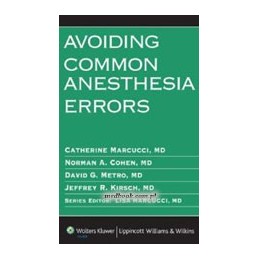- Obniżka


 Dostawa
Dostawa
Wybierz Paczkomat Inpost, Orlen Paczkę, DHL, DPD, Pocztę, email (dla ebooków). Kliknij po więcej
 Płatność
Płatność
Zapłać szybkim przelewem, kartą płatniczą lub za pobraniem. Kliknij po więcej szczegółów
 Zwroty
Zwroty
Jeżeli jesteś konsumentem możesz zwrócić towar w ciągu 14 dni*. Kliknij po więcej szczegółów
This pocket book succinctly describes 215 common, serious errors made by attendings, residents, fellows, CRNAs, and practicing anesthesiologists in the practice of anesthesia and offers practical, easy-to-remember tips for avoiding these errors. The book can easily be read immediately before the start of a rotation or used for quick reference.
Each error is described in a quick-reading one-page entry that includes a brief clinical scenario, a short review of the relevant physiology and/or pharmacology, and tips on how to avoid or resolve the problem. Illustrations are included where appropriate. The book also includes important chapters on human factors, legal issues, CPT coding, and how to select a practice.
Opis
AIRWAY AND VENTILATION
Basics
Advanced
Never neglect the basics of airway management
Basics of airway management-Part II (Tips and Tidbits)
Consider PEEP
Advanced:: A variety of techniques provide acceptable anesthesia for awakeintubation of the airway:: ultimately, the most important factorsare operator experience and adequate time
Special Cases:: A high inspired concentration of oxygen is contraindicated incertain circumstances
Remember that there are special considerations involved withboth intubation and chronic airway management of burn patients
Know how to perform a cricothyroidotomy
Perioperative Issues
Donts:: Do not overinflate the cuff of the endotracheal tube
Dont under represent the risks associated with the use of alaryngeal mask airway
Do not be intimidated by the placement and use of double-lumenendotracheal tubes
Do not underestimate the difficulty of reintubating a patient whohas undergone carotid endarterectomy or cervical spine surgeryDo not start the airway management of a Ludwig angina patientuntil personnel and equipment for a definitive (surgical) airwayare assembled
LINES AND ACCESSBasics::Remember that the IV start is your first chance to make a favorableimpression on the patient
Never use an intravenous line without palpating and inspectingit visually
Use of ultrasound guidance for cannulation of the central veinsimproves success rates, decreases number of attempts, and lowerscomplication rates
Central Lines::Central line placement:: never neglect the basics
Approach the use of a pulmonary artery catheter with caution
Avoid technique-related central venous catheter complicationsby using modern tools
Donts:: Dont overflush lines
Do not use the subclavian vein for central access of any type in apatient planned for dialysis
Errors:: Remember that inadvertent intra-arterial injection is not rare
Avoid errors in invasive blood pressure measurement
Remember that loss of a patent hemodialysis fistula in theperioperative period is a serious event for the patient and requiresimmediate communication with the surgeons
FLUIDS, RESUSCITATION, ANDTRANSFUSIONFluids:: Hypertonic saline:: the solution to the solution problem?
Remember that the synthetic colloid solutions have distinctproperties and risk/benefit ratios
Resuscitation::Protect the kidneys, not the UOP
Do not treat lactic acidosis with bicarbonate
Consider the use of tris-hydroxymethyl aminomethane (THAM)to treat refractory or life-threatening metabolic acidosis
Use the principles of damage control anesthesia in the care ofthe massively bleeding patient and ask the surgeons to implementdamage control surgery if necessary
Routine Labor and DeliveryLearn from the care of the combat victim:: ask the surgeons toconsider damage control surgery for the bleeding patient
Transfusion::Know what screening tests are performed on volunteer donorblood
Transfusion of packed red blood cells requires a careful riskbenefitanalysis
MEDICATIONS Perioperative issues::
INTRAOPERATIVE AND PERIOPERATIVE Basics::
REGIONAL ANESTHESIA
PACU
PEDIATRIC ANESTHESIA
NEUROANESTHESIA
CARDIAC ANESTHESIA
OB ANESTHESIA
PAIN MEDICINE
HUMAN FACTORS
LEGAL
PROFESSIONAL PRACTICE
CODING AND PAYMENT-MAKE SURE YOUGET PAID
COMMENCEMENT
Index
Indeks: 95614
Autor: IB Vijayalakshmi
Indeks: 82876
Autor: Virginia Berridge
